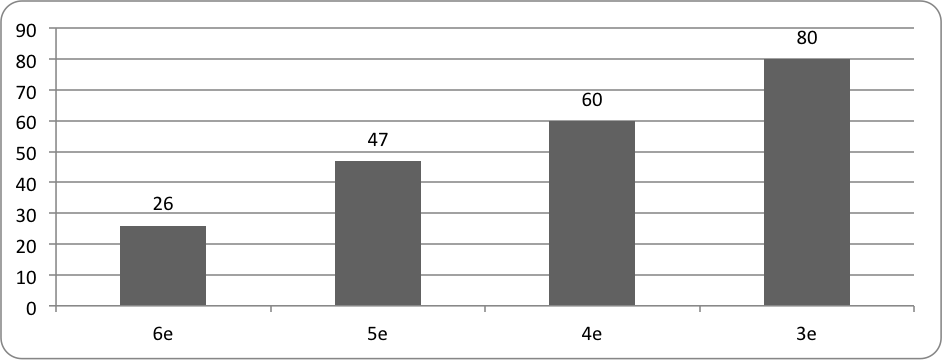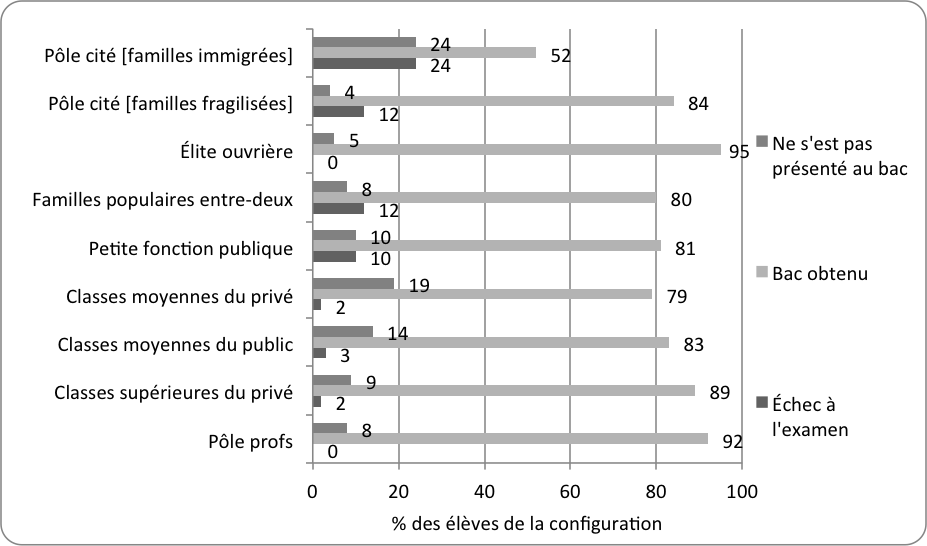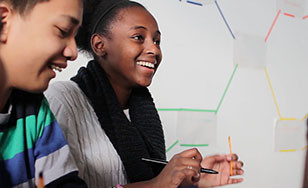How are inequalities in academic performance constructed over the course of schooling?
The latest French national data enable us to track a representative sample of students from the equivalent of the first year of middle school through the baccalauréat, France’s nationwide upper secondary school leaving examination. They show that in 2005, 87% of teachers’ children obtained the upper secondary degree as against only 39% of children of unskilled manual workers. On the basis of this finding, the sociologist Joanie Cayouette-Remblière decided to study in detail the schooling trajectories of two student cohorts from the first year of middle school through the end of high school and possible obtention of the baccaularéat degree. Her findings show that the observed inequalities are not givens but are constructed step by step within the French school system.
Trajectories apprehended through academic records
The sociologist drew primarily on students’ academic records to reconstitute the trajectories of all students attending two standard middle schools in the outskirts of Paris in 2001 or 2002—a total of 530 students. This material was supplemented with observation in the schools, interviews with teachers, and with some of the students themselves after they reached age 20 or 21.
Gaps widen in middle school
Tracking students’ marks trimester after trimester shows that it is in middle school that gaps widen. Though all students were taking the same classes in the same schools, students of working-class background made less progress than those of middle or upper-class background. Three overall explanations for these inequalities in progress may be discerned: a tension between working-class students’ ways of doing, thinking, speaking and acting and those demanded—but not taught—by schools; differences in schooling conditions; and students’ engagement in schooling or discouragement.
How students’ marks evolve through middle school (continuous assessment)

Note: Social origin was apprehended through the following set of variables (father’s and mother’s occupation(s) and stability over the years, family situation, number of siblings, cultural origin (by student’s first name)...).
Students who are cognitively switched off
One of the most striking manifestations of these inequalities in France’s comprehensive middle school system is what sociologists of the ESCOL team [Éducation et scolarisation, Université Paris 8] call cognitive switch-off. This term is meant to describe students who, while remaining in class, do not understand anything or and are not able to make sense of what people are doing there. Tracking students’ academic trajectories shows that the number who switch off cognitively increases with year in middle school. To determine those numbers we adopted what appears a restrictive definition of the phenomenon: all students whose marks are below average (below 10 out of 20) and whose teachers do not note any effort to learn on their part were classified as cognitively switched off. Of the 530 students studied, this applied to 26 in the first year of middle school but 80 in the last—despite the fact that 24 of the weakest students had already been pre-streamed into a vocational skills programme at a vocational training school.
Cognitive switch-off varies considerably by sex and social origin. 22% of boys and 13% of girls were in that state in their last year of middle school; 35% of students from “vulnerable families” and 26% from “immigrant families”.
The number of cognitively switched-off students rises from one year to the next of middle school

Comprehensive middle school—but then what?
One strong point of the survey was that it tracked the same students over time in different areas in the school system: primary school, middle school, general high school and vocational training. The fact is that though inequalities seem pronounced at the end of middle school, and though the difficulties that students of working-class background are likely to have in “general technological high school” (GT) are anticipated at the student orientation or streaming sessions held at the end of the last year of middle school, there is no certainty that students of working-class origin will succeed in either GT high school or vocational training.
For those who enter a GT high school, the difficulties mount: more rigorous academic requirements for students who cannot rely on help from their families; a greater increase in commuting time than for students of middle-class origin because working-class neighbourhoods are not as well served by the public transport system; little support from high school teachers for the efforts they make (everything seems to conspire to make those efforts invisible).
Unequal rates of access to GT baccalauréat degree programmes

Students who choose the vocational path from the start or after failure in a different type of high school are faced with academic requirements very similar to those in middle school and often encounter similar difficulties. Those of lower middle-class or relatively well-endowed working-class origin are the ones who most frequently obtain a vocational degree or pursue their studies and earn the baccalauréat degree.
Source: Joanie Cayouette-Remblière, 2016, L’école qui classe, Puf, Paris [FR]
Contact: Joanie Cayouette-Remblière
Online: February 2017

